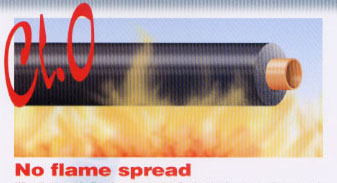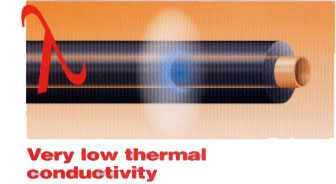


When fire tested Isoline does not generate flaming droplets, has no flame spread and has a low fire propagation index.
These combined meet the fire performance requirement of Class O as in Building Regulations.
Further guarantee is given by supervision contracts with independent European laboratories.

Isoline closed cell elastomeric insulation has a high diffusion resistance factor m that minimzes water vapour penetration, giving excellent long term performance.

Isoline thermal conductivity is l 0 oC = 0.035 W/mK .
The thermal conductivity is the most important factor in calculation fousec on energy saving.
Isoline Sheet rolls
|
||||||||||||||||||||||||||||||||||||||||||||||||||||||||||||||||||||||||||||||||||
Isoline Sheet flat
|
||||||||||||||||||||||||||||||||||||||||||||||||||||||||||||
| Data sheet | |
| Thermal conductivity DIN 52613 DIN 52612 B5874 part 2 1986 | l -20oC = 0.033 W/mK l 0oC = 0.035 W/mK l+20oC = 0.037 W/mK |
| Temperature range | pipes -45 oC to + 116 oC sheet -45 oC to + 85 oC |
| Water vapour diffusion resistance factor DIN52615
ISO9346 |
> m 7000 |
| Water vapour permeability BS 4370 DIN52165 | 0.09 mgm/N.h. |
| Water absorption % by volume after 28 days | < 1.1 |
| Flexibilty | Excellent |
| Ozone resistance | Good |
| Wall penetration standard fire test | Up to 180 minutes conditions similar to BS476 part 20 1987 |
| Resistance to oil and greases | Good |
| Resistance toU.V.and weather | Good * |
| Odour | Negligible |
| Reaction to fire:
B.S. 476 Part 7 1979 Ignitability: BS 476 Part 7 1987 Surface spread of flame fire propagation: B.S. 476 Part 6 1989 |
Class P
Class 1 Class 0 * |
| Italy CSE RF 3/77 France | Class 1 supervised M1-NF supervised |
| DIN 1988/7 corrosion risk | Meet limit values |
| Noise reduction DIN4109 | up to 32db (A) |
| Density | 65 to 80 Kg/m3
4 lb/ft3 to 5 lb/ft3 |
| % closed cells | > 90 |
| * Outdoor applications should be painted with isoline paint to the recommened thickness. Two or more coats may be required.
* Achieves Class o as defined in the 1991 Building Regulations (England and Wales) and the Building Standards (Scotland) Regulations 1990. |
|